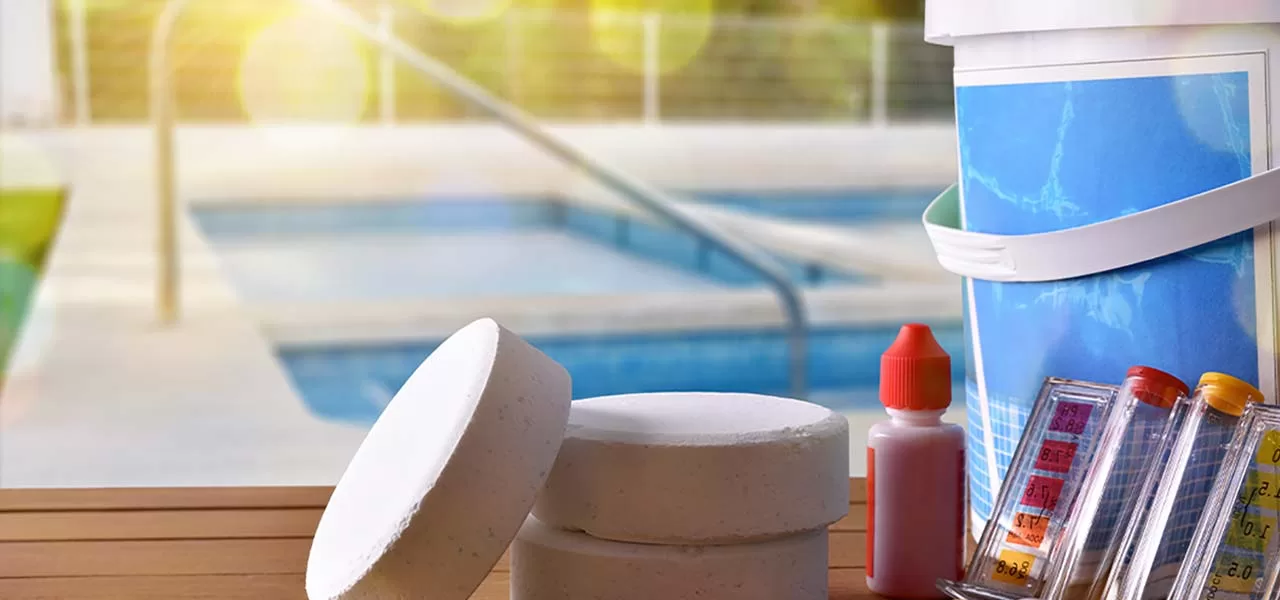FREE Standard Shipping On All Orders $100 or More!*

Bad Pool Chemical Combinations
There are a handful of water balance scenarios that can result in unfortunate side effects. In addition, there are some pool chemicals that should never be mixed or added to the pool at the same time. Once we've addressed those scenarios, we'll close with a brief discussion on best chemical safety practices to prevent accidents.
Let's dive in, shall we?
Bad Water Balance Combinations

As you're probably already aware, unbalanced pool water can cause a lot of problems. Bad water balance can cause poor water clarity, inefficient sanitation, stains and scale buildup, and let's not forget corrosion of pool equipment and accessories. If you're not familiar with proper water balance practices, visit our blog post, "The Ultimate Guide to Pool Water Balance."
High pH + High Calcium Hardness
This is a recipe for scaling and cloudy water. Can form scale film on pool surfaces and pipes, and can may even form sharp crystallized nodules of calcium that can snag swimsuits and scratch skin.
High pH + Low Chlorine
Perfect conditions for cloudy water and algae. Algae prefers a high pH level, and is just waiting for a low chlorine opportunity to bloom.
Low pH + Low Total Alkalinity
Will cause etching and corrosion to steel, copper, rubber, vinyl, and plaster surfaces. Acidic water wastes no time in corroding pool surfaces and equipment.
Low pH + High Total Alkalinity
Same as above, only it becomes harder to raise pH, due to the buffering effect of a high Total Alkalinity. You can find more in our blog about the relationship between pool pH and Total Alkalinity and how to fix balance issues.
Low Chlorine + Low Stabilizer
Low stabilizer can cause chlorine to be more quickly destroyed by the sun, which can compound the problem of low sanitizer levels. Hazy, to cloudy, to green is the usual progression of water in this condition. If you look at your pool carefully every day, you'll know just by looking at it when chlorine is low.
High Chlorine + High Stabilizer
This can damage soft and shiny surfaces over years of very high chlorine levels (5-10 ppm). Stabilizer (Cyanuric Acid) levels over 100 ppm can cause problems in chlorine potency, and chlorine testing becomes unreliable.
High Combined Chlorine
Chloramines are chlorine molecules that have joined with ammonia or nitrogen. No longer an active sanitizer, they cause red eyes and smelly pools. You can find chloramine levels by subtracting Free Available Chlorine from your Total Available Chlorine reading (TAC-FAC=CC). When chloramine levels exceed 0.3 ppm, shock the pool.
Low Calcium Hardness
Creates a corrosive water condition, which causes etching and leaching of calcium from plaster or tile grout. Low Calcium Hardness is also bad for vinyl liners when the water is too soft. It can hinder overall water balance and chemical effectiveness, too.
High Phosphates
Phosphates enter the pool from many sources, and are a favorite food source for algae. When a phosphate test exceeds 300 ppb (parts per billion), address levels with a phosphate remover.
Bad Pool Chemical Combinations

While balancing and maintaining your pool, you have to be very careful and deliberate with pool chemical applications. If chemicals are added in the wrong order, at the same time, or without enough time between applications, your pool can suffer. ALWAYS read and follow product label instructions to ensure the best results and prevent accidents.
Raw Chemical Interactions
Never allow pool chemicals to contact each other. Go back and read that sentence again. Harmful reactions may happen, even outside of the pool. Chlorine mixed with any other chemical or foreign substance can emit toxic gases, erupt in flames, explode, or all of the above. Always store chemicals in properly sealed containers in an area that's cool, dry, well ventilated, and secure.
Chlorine Shock + Algaecide
Chlorine shock will disrupt the polymer chains and chemical compounds used in many pool algaecides. In most cases, pool shock will completely destroy the algaecide. When necessary, use pool shock to kill algae, then wait to add algaecide until after the chlorine level has returned to normal. When adding algaecide, be careful not to overdose it, or you may end up with surface stains and foamy water, depending on which type of algaecide you use.
Chlorine Shock + Enzymes
Again, chlorine shock will break down any enzymes you put into the pool. If you're going to use enzymes, add them after chlorine levels return to normal. Otherwise, you're just wasting your money.
Chlorine Shock + Sequestering Agent
Chlorine shock will also disrupt stain and scale chemicals, a.k.a. chelators or sequestering agents, if they're added at the same time. Add stain and scale chemicals either a day before or several days after you shock the pool.
Chlorine Shock + High Metals
Metals in the pool can come from a few different things, the most common being your water source or poor water balance eroding the metals in your pool. When you have high metal levels, shocking the pool can drop them out of solution and cause pool stains. Keep pH, Total Alkalinity, and Calcium Hardness within range, and add a regular treatment of a sequestering agent like Stain Away or Metal Free to keep metals in solution.
Chlorine Shock + Trichlor Tablets
NEVER pour cal-hypo or dichlor pool shock into the pool through the skimmer. This is especially true if you have an inline automatic chlorine feeder filled with stabilized chlorine tablets. The resulting reaction between trichlor tablets and your pool shock can cause a chemical fire or explosion that will destroy your pool equipment and/or cause serious injury. Always follow product label directions when adding shock to your pool, and be sure to broadcast it evenly instead of concentrating your application in one spot.
Chlorine + Muriatic Acid
When mixed, these two chemicals create a dangerous toxic gas that can be harmful or even deadly if inhaled. Carefully read and follow product label directions to prevent an adverse reaction. Never add muriatic acid to the pool when chlorine levels are high, and don't shock the pool immediately after adding muriatic acid to the water.
Cyanuric Acid + Stabilized Chlorine
The only reason you should need to use stabilizer or conditioner, otherwise known as Cyanuric Acid (CYA), in your pool is if it's a fresh fill, if there's been a lot of splash-out that brought the levels too low, or if you're using an unstabilized form of chlorine as your primary sanitizer (such as with a salt water chlorine generator). Stabilized chlorine, like the 3" trichlor tablets in your chlorine feeder, contain a small amount of CYA in each tablet. If you're doubling up on CYA, you'll soon find that the levels are too high, and you'll have an even bigger problem to deal with to bring those levels back in range. Spoiler alert: it involves partially draining and refilling your pool to dilute it.
Calcium Hardness Increaser + pH/Alkalinity Increaser
Adding a Hardness Increaser too close together with sodium carbonate (pH Increaser) or sodium bicarbonate (Alkalinity Increaser) can cause an adverse reaction. The result is often cloudy water, but it can also cause small solids to appear in the water. In addition, this reaction can accelerate scale buildup in the pool.
Clarifier + Clarifier
If you overdose a pool with clarifier, a curious phenomenon can occur. Instead of behaving as a coagulant, the electron charge can reverse, causing some formulas to behave as a dispersant. Wait 5-7 days if you have to treat the water with clarifier again, and again, always follow dosing and application instructions found on the product label.
Best Practice Pool Chemical Tips

When it comes to pool chemical application, a few quick tips will help you avoid most of the scenarios listed above. These general chemical handling and safety guidelines will not only keep you safe, but they'll help to keep your pool safe and damage-free, as well.
Run the Pump
In most cases, pool chemicals should only be added to the pool when the pump is running. That said, there are a few exceptions to this rule. We've said it before, and we'll say it again, always, always, ALWAYS carefully read and follow the directions on the product label before applying any chemicals to the pool.
Wear PPE (Personal Protective Equipment)
When handling chemicals, it's important to wear personal protective equipment, including safety glasses and chemical gloves. Avoid inhaling fumes, and wear a respirator if necessary. Familiarize yourself with the safety data sheet (SDS) in case of accidental skin or eye contact, inhalation, or ingestion.
Prevent Negative Chemical Reactions – Read the Label!
Never add chemicals at the same time, whether you're balancing the water, shocking the pool, or adding a specialty chemical. For most water balance changes, the pump needs to run on the high setting for at least four hours before you can add another chemical or retest the water. The product label will provide more accurate instructions on wait times before adding more chemicals or going swimming.
If the chemical you're using requires dilution, always add chemicals to water. NEVER add water to the chemicals, or you'll risk initiating a dangerous chemical reaction. Start with a clean bucket of water, and dissolve the chemicals in the water before adding it to the pool.
Don't add anything to the water when chlorine levels are high. Some chemicals will be rendered useless, and others can start an adverse chain reaction. It's best to wait until chlorine levels return to normal before treating your pool any further.
Storage is Key
As we mentioned earlier, storing your chemicals properly is an important part of chemical safety. Containers should be properly sealed and stored separately in a cool, dry, clean, and well-ventilated area that can be easily secured. Children and pets should not be able to access your pool chemicals.
Conclusion
When used properly according to product label directions, pool chemicals are an important part of maintaining a healthy swimming pool. If you have questions about pool chemicals and specific water balance issues, check out our blog full of water chemistry and pool care tips!
Until next time, class is adjourned. Happy swimming!